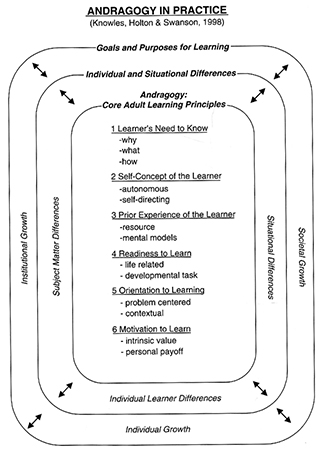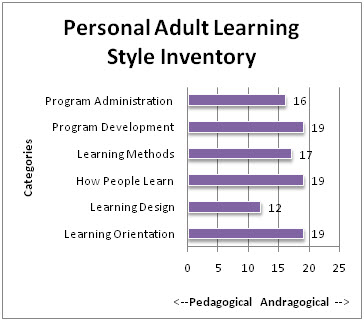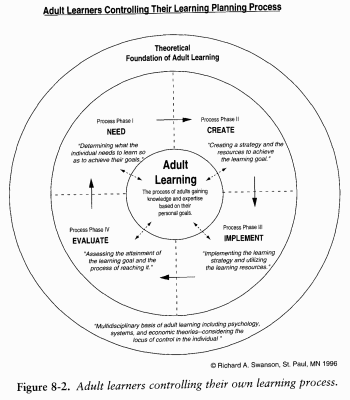Working with Adult Learners
Learning Environments
There are several environments where adults typically learn:
- Formal – highly structured, curriculum-driven, centered around grades and diplomas. Commonly known as “going to school.”
- Nonformal – organized learning opportunities, but not within the formal education system; commonly offered in a community-based setting like a library or civic center led by volunteers; cultural-based teaching as in one generation to the next
- Informal – learning derived from ‘managing’ one’s own life; self-directed learning projects, such as hobbies; learning to fill a need, such as information about a new medical diagnosis
- Human Resource Development (HRD) – corporate training organizations tasked with increasing employee performance; focus is on the employee’s contributions to the business, rather than development of the individual
(Merriam, 2007; Knowles, 2005)
Understanding andragogical frameworks
Learning theorists have tried to determine whether adults learn differently than children or animals. One researcher, Malcolm Knowles, introduced andragogy to educators in the United States in the 1970s, based on research under way in Europe. Since its introduction, researchers have tried to classify it as a theory, principles, guidelines, etc. But the key points don’t fit into any of these categorizations. What we do know is that these key points, which I’ll call a framework, work. Educators and facilitators who follow these principles report that they work because they are highly integrated, yet so flexible. Depending on the situation, andragogy can be used in whole, or in part.
Comparing an andragogical framework to pedagogy, the difference becomes clearer. Pedagogy – from the Greek words for “child” and “leader of” – is the art and science of teaching children. Andragogyis the art and science of helping adults learn. Learning is not the same as teaching. Pedagogy has the teacher in the central power role, whereas andragogy focuses on the learner and his needs.
Andragogical Principles from Knowles

There are six core principles to Knowles’ Andragogy framework:
- Learner’s need to know
- Learner’s self-concept
- Prior Experience of the Learner
- Readiness of the Learner
- Orientation to Learning
- Motivation to Learn
These principles live within the larger scopes of individual and situational differences, e.g., cultural background, race, gender, or sexual orientation, and goals and purposes for learning.
The Personal Adult Learning Style Inventory
The Personal Adult Learning Style Inventory, a self-assessment developed by Dr. Knowles (Knowles, 2005), is meant to help anyone who works with adult learners understand their own orientation towards various categories of instruction delivery and design.
In evaluating my own orientation, I can see that I am at a crossroads between my history, and my education. Assuming that an andragogical learning style is preferable because of its learner-centered nature, my orientation in Learning Design is most troublesome. In reviewing the answers to that set of questions, I see that my responses to two questions in particular about the trainer’s role in selecting the content are pedagogical. This goes back to my role as a writer for a curriculum that has no place for self-directed learning. The business dictates that the student knows certain things, and learns them in a certain way. As I’ve learned since using this inventory, the fact that my role as a writer is within the HRD realm, I understand more completely why I have a pedagogical orientation in Learning Design.

Andragogy vs. Human Resource Development (HRD)
Knowles defines human resource development as “a process of developing and/or unleashing human expertise through organizational development and personnel training and development for the purpose of improving performance at the organization, work process and individual levels.” (Knowles, pg. 170, italics added). Andragogy’s central concept is that learners want to, or need to, control their learning. Does a learner need to suspend his desire to control his learning for the sake of a paycheck? This is the potential conflict between andragogical frameworks and HRD.
A learner’s level of control varies depending on the circumstances of his learning. Some learning just happens; the learner has no control. His has his greatest level of control with self-directed learning. Authority-directed learning, such as what often exists with HRD, provides the learner with little or no control (Knowles, 2005).
But what if HRD could find a strategy for involving the learner in deciding what he needed to know? What if the learner helped plot the course his training would follow? Could HRD adopt a mediated learning configuration, where there was shared control between the learner and the authority?
(Knowles, p.181, after Swanson 1996)
Swanson proposed a four-phase cycle that learners follow when controlling their learning (see above). Placing this cycle into an HRD setting, and having a mediated learning configuration as the goal, I hypothesize that the following could work in many situations:
- The Need phase would be a predominately HRD-controlled phase. Things in this phase would be defining job descriptions, organizational chains-of-command, specific task-based skills, etc.
- The Create phase could be a 70-30 split between HRD and the learner. This could be facilitators presenting learners with several strategies for reaching their learning goals.
- The Implement phase would probably be 60-40 split between the learners and HRD. The learner would select one or more of the strategies and then follow through the learning path.
- The Evaluation phase would probably be another 60-40 split between the learners and HRD. A strong emphasis on meta-cognition would be important.
Ethical Behavior
Growing up, it seems to me that ethical and moral behavior was rarely a concern. Of course there was the odd-character who didn’t seem to get it that there is a social contract by which we all must live; but these guys stood out, we knew who they were a mile away.
Now, it’s not so easy to know “the right thing” to do, to say, to feel, or to believe. Political correctness, and the anti-PC backlash, has tried to persuade us in all directions, leaving us in a heap of confusion. Teachers/facilitators are more heavily scrutinized than an average citizen because they are entrusted with helping us raise our children (in most cases) to be quality citizens. Since we have so few ethical and moral leaders, it is even more important that teacher/facilitators develop their own personal standards, aligned as closely as possible with the social contract at large, and with their specific organizations; and then they must live out their standards in front of peers, learners, and the community.
Understanding our own biases
Bias Blocks Learning – a Power Point presentation that discusses some of the thoughts I had after reading about how cultural backgrounds impact learners, and may inappropriately influence teachers/facilitators.



